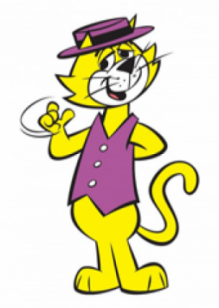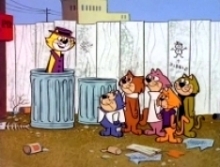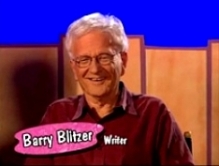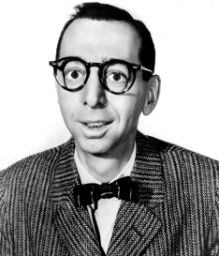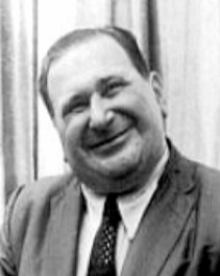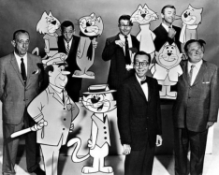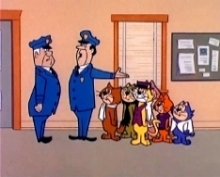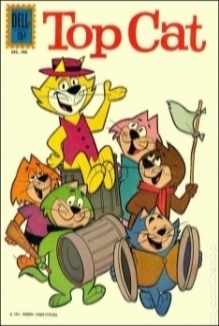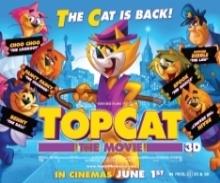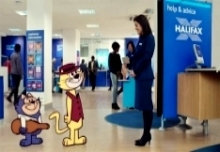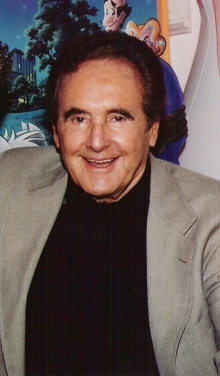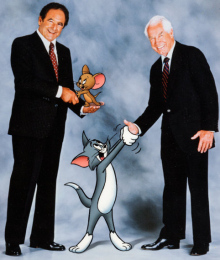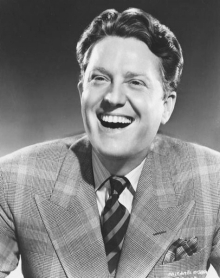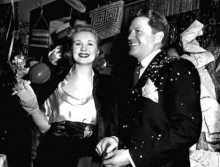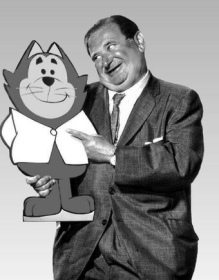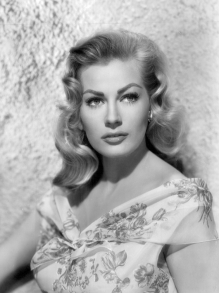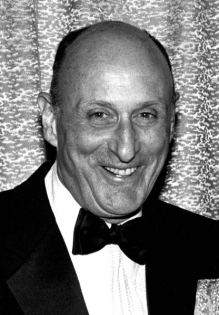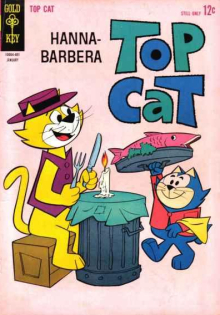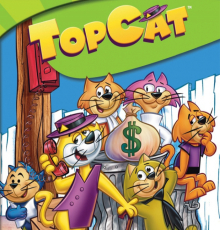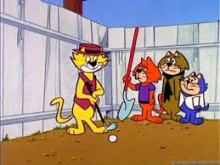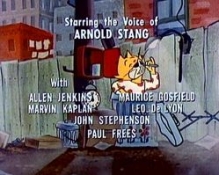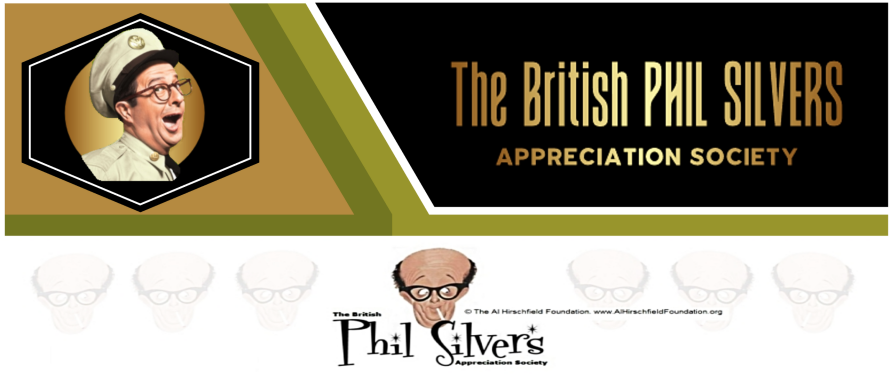Top Cat
Following the huge success of their previous animated series The Flintstones, William Hanna and Joseph Barbera were looking to produce another hit animated series for primetime television aimed at the newly-named 'kidult' market.
The Flintstones had been loosely based on comedian Jackie Gleason's hit 1950's sitcom The Honeymooners, in which Gleason played Ralph Kramden a New York bus driver forever inventing get-rich-quick schemes for him and his best friend, Ed Norton, played by Art Carney.
Barbera, in a clever twist which would allow for a host of comic opportunities, transported the central characters back to the Stone Age. It proved to be a master- stroke and remains one of the series' enduring strengths.
Turning once again to television sitcoms for inspiration, and on the back of a sketch for a proposed show called J.B & Company they developed Top Cat, using The Phil Silvers Show and in particular the character of Sgt.Bilko as their main influence.
Joseph Barbera produced two scripts and a host of character sketches. Once again Barbera, realising the comic opportunities it would afford the show, came up with a bizarre twist in which the main characters were of the feline variety. TC and his gang were born, and it was on the strength of these initial ideas and sketches that the ABC Network gave the show the green light.
Transforming the wily Sergeant and his army cronies into a bunch of New York alley cats and their quick thinking leader TC, Hanna-Barbera produced one of their most sophisticated, adult-friendly and character-driven shows which still resonates with both children and adults today.
The Bilko connections continued when former Bilko scriptwriter Barry Blitzer, who had also worked on The Flinstones, was draughted in to provide scripts. Actor Maurice Gosfield, who had achieved world-wide fame for his role as Private Duane Doberman on The Phil Silvers Show, was hired to provide the voice of Benny The Ball - in what was essentially an animated re-working of Pvt.Doberman.
Fleshing out the talented vocal cast were Arnold Stang as Top Cat. Arnold was a seasoned and popular actor and comedian who had worked with the likes of Milton Berle and Steve Allen. Veteran Allen Jenkins (Officer Dibble) was a former Warner Brothers contract player who'd appeared in over 100 films and had worked with performers such as Paul Muni, James Cagney, Abbott & Costello and Lucille Ball. Maurice Gosfield was hired to voice Benny The Ball, in a relationship to Top Cat that was very much akin to that of the one between Private Doberman and Sgt.Bilko.
Rounding out the vocal cast were popular character actor Marvin Kaplan as Choo Choo, Singer and pianist Leo De Lyon, who had already worked for Hanna-Barbera on The Flintstones was hired to provide the voices for both Brains and Spook, and John Stephenson, who had enjoyed a lengthy career in both television and films was cast as Fancy.
Arnold Stang recalled how he became associated with the show. "I started doing cartoons when they were only made for movie theatres. I did Little Lulu, Popeye, Herman The Mouse. I voiced a lot of animals....I played a lot of turtles, mice, once a played a 900lb gorilla. I had a meeting with Joe and Bill and I came up with some voices. I came up with one that had sort of a little bit of a Phil Silvers/Sgt.Bilko quality to it and that was the one we went with."
Fellow cast member Maurice Gosfield remarked "The atmosphere surrounding the group at the Top Cat recording sessions is ideal for a sociable soul like me. It's kind of like the old radio days, from which most us graduated. It's hard work, but it's fun. There's a rare spirit of camaraderie among the group and it reflects in the show."
When I interviewed Arnold Stang in the late 1980's he talked of his memories of working on Top Cat. "There was a company called Hanna-Barbera who I had already done some voices for. They asked me to come in and do some voices for a new show about a gang of alley cats. I pretty much worked for all the major animation studios at that time. It was very clear to me and to most of us on the show, that whoever had put the show together had undoubtedly been influenced by Sgt.Bilko. There were very direct parallels no question about it.".
He also spoke with great warmth about his fellow co-star Maurice Gosfield. "Maurice was a very sweet man. Not what I would call an actor but a great character. Sadly he's dead now...but a lot of people don't realise that. I get a lot of mail about Top Cat and very often people want to know about BENNY..."Where is he now? What is he doing now?...those sort of questions!".
Marvin Kaplan, the voice of Choo Choo, recalled "It was a different kind of cartoon. It was a very intelligent show. Nowadays when they do a cartoon it's full of grunts and people fall off mountains and it's very violent. Top Cat wasn't...it was very good humour, adult humour and we even had an adult slot at night, which was very unusual for a cartoon series!".
Top Cat premiered on the ABC Network on September 27, 1961 at 8.30pm, nestled securely between two of ABC TV's biggest hits, The Steve Allen Show and Hawaiian Eye. It was only the second animated series, following The Flintstones, to be shown in an adult slot on primetime television. It ran for a total of 30 episodes, with the final episode broadcast on April 18, 1962. Interestingly, although filmed in colour, the show was initially broadcast in black and white.
The series proved a modest hit and was eventually sold for broadcast in over 30 countries worldwide. It became particularly popular in South America, particularly Mexico, where it was known as Don Gato Y Su Pandilla (literally translated as Don Cat & His Gang).
When it aired in the UK in 1962 it was renamed Boss Cat shortly after it's premiere because at that time Top Cat was also the name of a popular British brand of cat food.
Between 1961 and 1970 TC and the gang also featured in a series of 31 comics published by Dell. A further 20 comics were issued by Charlton Comics, ending its run in 1973. Three Top Cat Annuals were also published by World Distributors.
In 1985 Arnold Stang reprised the role of TC (minus the old gang) for the new Hanna-Barbera series Yogi's Treasure Hunt, and 1987 saw the return of both TC and his gang in the all-new animated feature Top Cat & The Beverly Hills Cats.
This new production was written by original series writer Barry Blitzer and saw the return of the original voice-cast, with the exception of Maurice Gosfield andAllen Jenkins, who by this time had passed away.
Arnold voiced TC for one final Hanna-Barbera show titled Wake, Rattle and Roll, which featured a mix of both live-action and animated content. One segment of the programme featured a Monster Truck race show (the 90's equivalent of Wacky Races) called Fender Bender 500. Arnold's old friend and fellow Top Cat and Mad World cast member, Marvin Kaplan was also along for the ride, providing the voice of TC's co-driver Choo Choo. Fender Bender 500 ran for a total of 50 episodes.
Our enduring feline hero and his gang of cronies were resurrected once again for a feature-length animated film Top Cat: The Movie (Original title - Don Gato Y Su Pandilla). The film, co-produced by Anima Estudios and Illumination Studios, received a general release in South America on September 16, 2011. TC and his cronies proved to be as popular as ever and the film was both a box-office and critical success.
An English language version of the film was released to the European, US and UK markets in June 2012. To date the film has made almost $16 Million at the box-office. The film also received a general release on both Blu-Ray and DVD format in late 2012.
Whilst proving a success in South America, the film received poor reviews in both the US and UK and was not deemed a success. A sequel called Top Cat Begins from the first film's producer Jose Carlos Garcia was released in 2016 and hits UK cinemas on May 27th. Unlike it's predecessor the new film stepped away from the traditional use of animation and was produced using CGI characters and backgrounds.
Most recently Top Cat resurfaced yet again when it was announced that the character would front the latest advertising campaign for the latest range of Halifax mortgages.
In 1994 Joe Barbera released his autobiography, My Life in 'Toons, in which he recalled his life and career, what actually inspired him to draw and his life-long partnership with Bill Hanna. In this excerpt he recalls his memories on the birth of Top Cat.
"Buoyed by the success of The Flintstones, I started thinking about another half-hour prime-time cartoon show, loosely inspired by You’ll Never Get Rich, the hilarious army-life comedy series that ran from 1955 to 1959, starred Phil Silvers as the always-scheming Master Sergeant Ernie Bilko, and featured a supporting cast of his devoted motor-pool platoon at mythical Fort Baxter, Kansas.
I quickly sketched a single drawing of a smart-aleck cat I dubbed Top Cat and handed it to Ed Benedek, who worked the sketch into a finished piece of artwork. I walked into a meeting with ABC TV’s Ollie Treyz, showed him the drawing, and said it was a cat who lives in an alley with a lot of other smart-aleck cats, all living by their wits and sheer guile, and all looking to Top Cat as their leader.
The Flintstones had taken eight weeks of forty-five to ninety-minute dog-and-pony-show pitches to sell. Now Ollie Treyz looked at me, looked at the drawing, and said: “Okay I’ll take it.” Unfortunately, the rest of what I had to do was not as easy.
More than any cartoon we had ever done before—even more than The Flintstones—Top Cat would depend on characters, casting just the right voices, and that process proved to be even more of a time-consuming ordeal than usual. Perhaps it was because Top Cat was, in a way, closer to me than any cartoon I had done before. It came out of an urban milieu I knew very well.
No, I didn’t grow up in an alley, and, while my family was always short on money, we never had to cadge a meal. But, for me, New York was a place that demanded all your wit to survive, let alone get ahead. It helped if you were the kind of smart aleck who knew all the angles and whose smooth-talking charm would give you the force of personality that made you top cat. Damon Runyon knew all about this. Phil Silvers knew it, too. And so did I.
After auditioning a lot of actors, I ended up, logically enough, with an ex-cast member of You’ll Never Get Rich in a key role. Maurice Gosfield, who had played Private Duane Doberman, became Top Cat’s good-natured little sidekick Benny the Ball (if TC resembled Yogi Bear, Benny was the equivalent of Boo Boo). In addition, after much auditioning, I found Marvin Kaplin to play Choo Choo, Leo de Lyon as Spook and The Brain, John Stephenson as Fancy-Fancy, and Allen Jenkins—a veteran Warner Bros. character actor known for his gallery of supremely numbskulled small-time hoods—for the role of Officer Dibble.
But the character of Top Cat himself proved elusive. After months of casting, I settled on Michael O’Shea, who was known for his film roles as the kind of suave, easy-going leading man with a touch of Brooklyn in his voice that seemed just right for Top Cat. O’Shea, married to the glamorous Virginia Mayo, was probably best remembered as Jack London in the 1943 film of the same name, and he also starred between 1954 and 1956 in a successful TV series called “It’s a Great Life,” about a pair of recently discharged GIs trying to adjust to civilian life. My high hopes for O’Shea were confirmed in rehearsals, where he seemed to take to TC very naturally.
Then came the first night of recording (as with all our cartoons, recording always took place at night, at the end of a very busy, very tiring day). In walks O’Shea, duded up like a dandy from another age: old-fashioned three-button suit, big silk tie, archaic homburg hat, and gray suede gloves. Well, ordinarily, I don’t much care how a man dresses, but something in the way he looked telegraphed trouble. And trouble I got.
This man, who had been just fine in rehearsal, simply could not handle the rapid pace of cartoon television dialogue. His lines came out flat, or flubbed, or, at the very best, just plain wrong.
All I could think was how I’d just squandered months in casting only to come up with exactly the wrong man. And that’s when I went home, thoroughly drained and dispirited, but just as completely unable to sleep, thinking, as I stared at the shadows shifting across the bedroom ceiling, What have I done? And what am I going to do now?
The answer came in the form of a great little actor with horn-rimmed glasses, pop eyes, a cockeyed smile, and a trademark bow tie. He looked not at all as I imagined Top Cat, but he sounded perfect: a nasal blend of streetwise expressiveness with just a touch of the carnival barker’s whine.
His name was Arnold Stang and he had been on radio since the age of ten and was a successful television comedian (a regular on “Henry Morgan’s Great Talent Hunt,” a very early comedy variety series, and on “The Milton Berle Show”) and a great character actor, whose single most memorable role was as a derelict named Sparrow in The Man with the Golden Arm.
With the casting hurdle successfully cleared at last, we plunged headlong and happily. Recording sessions would not usually break up until 11:30 or even midnight, and we’d go across the street to the Naples Restaurant on the corner of Gower and Sunset, where I’d buy the cast dinner.
Seven or eight of us would sit there, talking about the show and talking about our lives. I remember Maurice Gosfield—Bilko’s stubby Private Doberman and now our Benny the Ball—consuming a huge plateful of clams on the half shell. It was not a pretty sight.
He’d pick up clam after clam, suck in the solid contents and slurp in the buttery juice—or at least a portion of it. Much of the stuff never reached his mouth, running in rivulets down his wrist, over his wristwatch, into his sleeve, and onto his shirt. And through this all, he’s talking, and always sounding in character, sort of an urban version of Andy Devine.
“I used to go with Anita Ekberg,” he told us, amid exuberantly animalistic sci-fi slurping effects, fingers coated in butter, pausing to discard one spent shell and retrieve a fresh one. “But, you know, something was wrong with her.”
Then a long interval of sliding and slurping until one of us finally said, “What, what was wrong with Anita Ekberg?”...“She had no class.”
Then, dumbfounded and open-mouthed, you’d watch this little guy get up from the table, go out, get into his car, which was parked on Sunset, and pull out of his space. This he did in much the same way as he ate, throwing the car into reverse, stomping the gas, banging into the car behind him, making a little more room there, shifting into drive, stomping, banging into the car in front of him, making a little space there, repeating the process in reverse and in forward, then pulling back for one final impact before speeding off for a home without Anita Ekberg.
It was all a lot of fun, and I thought the show was going just great. Then, at about show number seven, Screen Gems’s John Mitchell and Jerry Hyams came out to look at the material. They did not like what they saw.
John pulled no punches. “What the hell is going on here? Where are the laughs?” I was stunned. But his next comment was insightful and a lot more helpful. “This isn’t a cartoon. You’re missing the cartoon laughs.”
He was right. In one respect, we had made Top Cat look more like the traditional theatrical cartoons than, say, “Huckleberry Hound” or even The Flintstones. Limited animation, of course, was still the order of the day—but, in Top Cat it was richer, fuller, more complex, and the backgrounds, too, were more detailed and elaborate.
Yet, in another, more important way, I had taken a fatal detour from cartoon tradition. The great mix of urban alley cat characters had generated a lot of nifty dialogue, and I got carried away with it at the expense of the purely visual humor that must be a part of any successful cartoon. We might as well have been doing live action. There were no cartoon sight gags.
I had committed the very crime for which I had earlier junked the “Flintstones” scripts by that ex-“Honeymooners” writer. I had seven shows in the can, and, believe me, I had no desire to do any part of them over again. But I was honest enough with myself to know that John Mitchell was right, and if I let these shows go as is, Top Cat would evaporate in a single season or less. So I went over each cartoon and put in the kind of material that should have been there in the first place.
For example, there was one scene in which TC lays out a con game for the gang. As I had originally written it, it was just straight dialogue: talk, talk, talk. Now I went back in and gave Top Cat a golf club. With The Flintstones, we had discovered the laugh potential of props that grew out of the show’s major premise: a stone-age boulder for a bowling ball, a Stoneway piano, a mini-mastodon as portable vacuum cleaner, and so on.
The prop premise of Top Cat was that, suave urban sophisticate that he was, TC would possess all the finer things in life—but translated into terms of the alley. His best-known prop was the telephone, indispensable to every wheeler-dealer, but in this case it was the official police call box mounted on a telephone pole and conveniently appropriated by TC whenever the need arose.
Thus the golf club I gave Top Cat was a piece of pipe with an elbow joint screwed onto the end. Now, like many another self-respecting top exec, TC briefed his lieutenants while practicing his putting. Benny the Ball, as caddie, held a stick with a rag flag attached to mark the hole, and each time TC hit one his entire entourage would work like mad, laying pipe, screwing in angles and elbow joints to guide each and every ball to a hole-in-one. This was a cartoon gag—and all the while it went on, the necessary dialogue proceeded.
Even with the traditional cartoon gags installed, Top Cat for me, always seemed strangely close to life in the real world. One of the early Top Cat episodes was called “The Maharajah of Pookajee,” and in it Top Cat and his gang disguise themselves as the maharajah and his retinue in order to gain access to a real maharajah, fabulously wealthy and ensconced in an elegant hotel, famed for casually dispensing rubies and diamonds.
This was based entirely on an incident that had taken place at Hollywood’s celebrated Ciro’s restaurant. A local prankster circulated a rumor about an obscure Middle Eastern potentate known for tipping waiters not with coins, but with priceless gems. He then costumed himself and retinue appropriately, telephoned Ciro’s, secured a prime table, and received the royal treatment generally.
After dining, on the way out of the restaurant, the potentate claps, his retainer produces a pouch, the maharajah reaches in, withdraws a handful of gemstones, and presses several into the palm of the openmouthed maitre d’. In the process, a few jewels fall to the floor.
A member of his retinue springs forward to retrieve them, whereupon the maharajah wordlessly raises a finger and shakes it dismissively, as if to say, “Don’t bother with such trifling trash.” With that, the potentate and his retainers leave Ciro’s, and, in Three Stooges fashion, a dozen waiters, headwaiters, and Ciro’s customers pounce on the fallen jewels.
Of course, the gems proved to be glass, the newspapers later revealed the prankster’s con, and I sketched it out as the basis of a very funny TC episode—just one of many that, in terms of script, made this show probably the most sophisticated cartoon series Hanna-Barbera ever produced."
